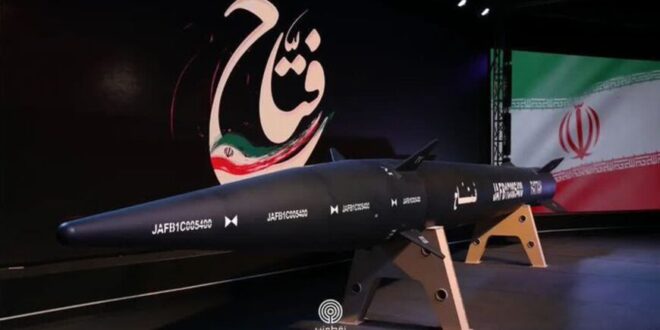Boastfully adding to its already massive stockpile of long-range projectiles, Tehran appeared headed for a fresh collision course with Israel and its Western adversaries, which remain unnerved by Iran’s missile program.
Iran unveiled on Tuesday what it described as its first domestically developed hypersonic missile, pressing ahead with the controversial program that it considers a vital deterrent factor against the United States, Israel and other adversaries.
The missile, dubbed Fattah (Persian for “conqueror”) was designed and developed by the Aerospace Department of the Islamic Revolutionary Guard Corps (IRGC), state media reported.
“We have gained deterrence,” announced hard-line President Ebrahim Raisi during the televised unveiling ceremony in Tehran, adding that pressure from “the enemies” will not “push the missile program to the corner.”
Describing the missile as a strategic achievement, the IRGC-linked Tasnim News Agency said Fattah is equipped with a two-stage solid fuel engine and boasts a range of 1,400 kilometers (869 miles). The missile “has a top speed of over 9,000 miles per hour,” the report added.
Iran’s missile chief and IRGC aerospace commander, Brig. Gen. Amir Ali Hajizadeh, claimed in an address at the same ceremony that no existing missile defense system was capable of “intercepting and beating” the Iranian projectile. “It will be decades,” he noted in November, “before any such shield is introduced.”
The stunning moment of impact from 🇮🇷 Iran's newly unveiled hypersonic and precision-guided Fattah missile strike. pic.twitter.com/V1LvEZt3aQ
— PressTV Extra (@PresstvExtra) June 6, 2023Less than a fortnight ago, the Islamic Republic test-fired a new ballistic missile with a range that could nominally hit targets as distant as Israel, the country whose annihilation has been central to the Islamic Republic’s rhetoric.
Following the inauguration of the hypersonic missile, Iran’s state media were quick to pick up a Jerusalem Post story that highlighted the missile’s potential capability of reaching Israel in a matter of 400 seconds.
To Israel, as well as Western powers and some Arab states, Iranian missiles are a destabilizing threat, particularly as they see the projectiles being frequently shipped to Palestinian militants, the Lebanese Hezbollah movement, Shiite fighters in Iraq as well as Houthi rebels in Yemen.
The ceremony in Tehran converged with the latest diplomatic pushes — including reported Omani mediation — aimed at restarting the long-stalled talks between Tehran and Washington for the revival of the 2015 nuclear deal, which has never ceased to be intertwined with the Islamic Republic’s missile program.
The unveiling could once again also bring into the limelight Iran’s contentious military cooperation with Russia, which has been allegedly receiving Iranian drones since its invasion of Ukraine. While the Islamic Republic says the new missile was entirely indigenous, the argument may not put to entire rest the speculation that Moscow could be secretly supplying Tehran with the hypersonic technology.
With the new projectile, Iran will be placed among the four top states owning the hypersonic missile technology, Hajizadeh said in the Tehran ceremony.
His superior, IRGC chief Maj. Gen. Hossein Salami, went further, declaring that the expertise his forces utilized in developing Fattah remains an uncharted territory “to most of the countries in the world.”
 Eurasia Press & News
Eurasia Press & News


